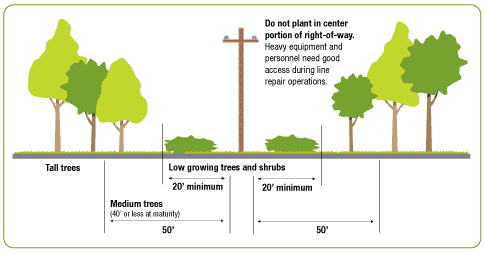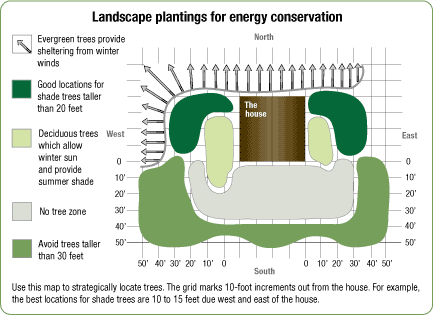Planting adjacent to overhead power lines
You can help minimize tree-related outages and ensure reliable electric service for the future by choosing the right species of trees. Consider the trees' mature height and crown spread, especially when planting adjacent to overhead power lines. Avoid planting directly underneath power lines. Make sure any tree planted within 20 feet of neighborhood power lines is a variety that will grow to a mature height of 15 feet or less. Small trees such as flowering Techny arborvitae, dogwood or nannyberry are ideal for these locations.
Plant taller trees farther away to ensure they can't grow into power lines. At distances of 20 to 50 feet, plant trees that grow to a height of 40 feet or less.
If you want to plant a tree that grows tall, such as a maple, oak, pine or spruce, make sure it's at least 50 feet from the nearest residential overhead lines.
When you select trees, consider how you plan to use the site, as well as area safety needs.
Download Plant Wisely brochure for more information.

Tips for safe planting around pad-mounted transformers
-
The minimum distance required when planting near pad-mounted transformers is 3 feet of space on sides and back of transformer and 10 feet of space in front of the transformer (padlock side).
-
Remember the transformer must be accessible for service at all times.
-
Select plants that are easily maintained and suitable for the site.
-
Allow plants sufficient growing room.
-
Do not allow plantings to grow over the transformer.
-
Do not change grade levels around pad-mounted transformers.
Planting for energy conservation
By planning a well-landscaped yard, you can have a real impact on your home heating and cooling costs.
Deciduous trees planted to the west and east of your home will help keep it cool in the summer and allow solar benefits in the winter. Trees function as natural air conditioners. As water is drawn from the ground to the leaves, water vapor is released, cooling the surrounding air. Evergreen trees along the north side can reduce the cooling effects of winter winds.
Download the "Save Energy with Trees" guide provided by the Minnesota Department of Commerce Energy Information Center for more information.

Diagram source: Minnesota Department of Commerce Energy Information Center
Whether you're looking for more summer shade, an effective windbreak or just to enhance the beauty of your property, start by selecting the right tree for your location. Consult with your local nursery person, or local Soil Water Conservation District (SWCD) office or your county agricultural extension agent. If your planting area has power lines nearby or if you have any questions, call the toll-free number below to reach our Forestry Services Staff, or feel free to contact us via email with your concerns or inquiries.
Trees or Vegetation Questions - 1-866-293-9068
Call before you dig
To locate underground utilities contact:
Gopher State One Call: (Minnesota) 1-800-252-1166 or 811 two business days ahead.
www.gopherstateonecall.org
Digger's Hotline: (Wisconsin) 1-800-242-8511 or 811 three business days ahead.
www.diggershotline.com
